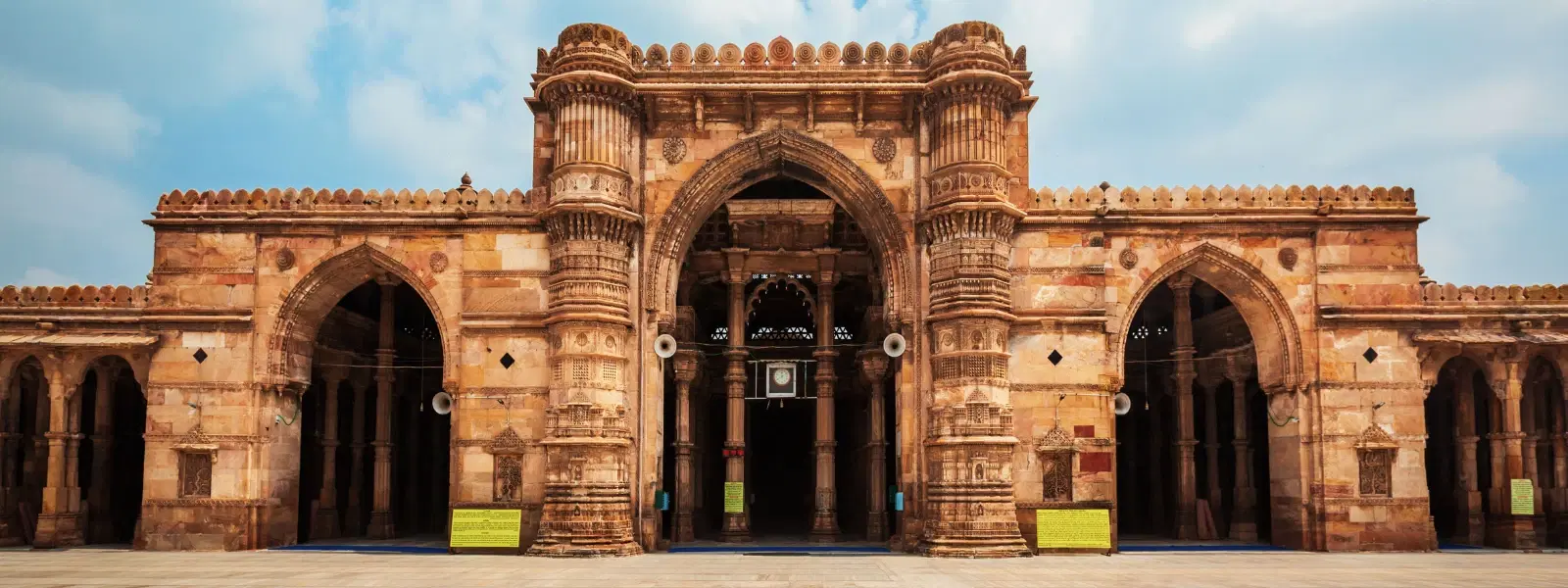
Hotels
•03 min read

Jama Masjid Ahmedabad stands as a brilliant testament to the rich tapestry of India's architectural heritage. The mosque's unique blend of Islamic and Indian design, known as the Indo-Islamic style, beckons travelers and history enthusiasts alike to explore its intricate beauty and profound cultural significance. In this blog, we answer frequently asked questions about the mosque's architecture, delve into its historical context, and highlight the artistic details that make it a must-visit heritage site.
Indo-Islamic architecture is a fusion of Islamic elements, such as domes, arches, and minarets, with traditional Indian motifs and craftsmanship. This style emerged during the medieval period in India and played a crucial role in shaping the design of many mosques and monuments across the country. Its ability to blend diverse cultural influences has made it a symbol of harmony and artistic excellence in Indian architecture.
Mosques built in this style typically showcase a range of stunning features, including:
Grand domes
Soaring minarets
Beautifully arched entrances
Delicate stone carvings
The Jama Masjid in Ahmedabad exemplifies these elements with its well-proportioned prayer halls, intricate patterns, and elegant calligraphy that adorn its walls. Such details not only serve aesthetic purposes but also tell stories of the craftsmanship during the Sultanate period.
Constructed during the Sultanate period, Jama Masjid Ahmedabad is steeped in history. It was established by a visionary ruler, reflecting the political and cultural ambitions of its time. The mosque's foundation is interwoven with episodes of regional history, making it a focal point for those interested in exploring India's past.
At the heart of Jama Masjid lies a spacious prayer hall, flanked by tall, graceful minarets that pierce the sky, a testament to the architectural ingenuity of the era. A prominent ablution tank enhances its practicality and beauty, offering a quiet space for ritual cleansing. Intricate stone carvings, replete with floral and geometric designs, adorn the interior and exterior, revealing the deep artistic sensibilities of the period.

When compared to other famed Islamic monuments like the Sidi Saiyyed Mosque or Sarkhej Roza, Jama Masjid holds its own with distinctive features that make it unique. While each monument tells its own story of Indo-Islamic artistry, Jama Masjid's expansive prayer area, detailed carvings, and the harmonious integration of structure and symbolism set it apart as a jewel among Ahmedabad's historical mosques.
Jama Masjid is not just an architectural marvel; it is a cultural beacon that safeguards the legacy of Indo-Islamic heritage. The mosque is central to the cultural landscape of Ahmedabad, offering insights into the synthesis of artistic traditions and serving as a reminder of India's diverse historical narrative.
For those with an affinity for history and art, Jama Masjid is a treasure trove. Its strategic location in the historical district of Ahmedabad makes it easily accessible, inviting both casual visitors and dedicated history buffs to immerse themselves in its serene ambience and timeless beauty.
The mosque's stone carvings are a visual delight, featuring delicate floral motifs and precise geometric patterns that capture the essence of the Sultanate period’s craftsmanship. These carvings not only beautify the structure but also narrate tales of the past, inviting viewers to look closer and appreciate the detailed artistry that went into their creation.
Embodying true Islamic art, the calligraphy within Jama Masjid blends seamlessly into its overall design. The inscriptions, rendered in elegant scripts, serve both a decorative and symbolic role. They are a reminder of the mosque's sacred function and its place in the continuum of Islamic art and architecture.

The Jama Masjid in Ahmedabad is designed in the Indo-Islamic architectural style, blending Islamic and Indian design traditions.
The mosque features a large prayer hall, intricately carved stone pillars, domes, minarets, and an ablution tank, all showcasing the Indo-Islamic style.
Indo-Islamic style is an architectural fusion of Islamic elements like domes and arches with Indian motifs, materials, and construction techniques.
The Qutub Minar complex in Delhi is considered one of the earliest examples of Indo-Islamic architecture in India. However, historical debates exist regarding this claim, and some scholars suggest other sites may have influenced its development.
It is a historical and cultural landmark that exemplifies the Indo-Islamic style and serves as a testament to the architectural brilliance of the Sultanate period.
Did you know? Jama Masjid Ahmedabad is a perfect example of how Islamic and Indian architectural traditions were harmoniously blended during the Sultanate period, creating a style that is both unique and timeless.
Jama Masjid Ahmedabad encapsulates the elegance and depth of Indo-Islamic architecture. Through its intricate carvings, historical ambiance, and cultural significance, the mosque offers a window into India's diverse artistic heritage. Whether you are a dedicated history enthusiast or a curious traveler, exploring this heritage site is a journey into the heart of India's grand architectural tradition.